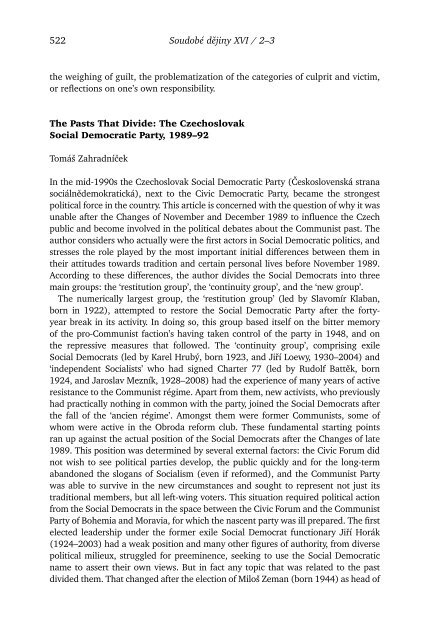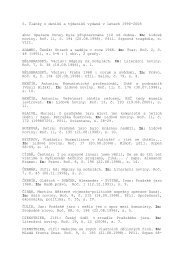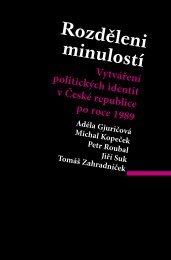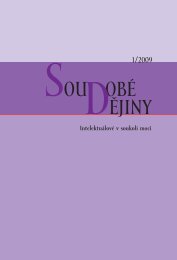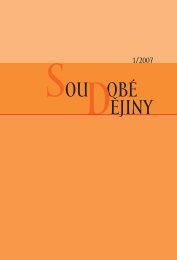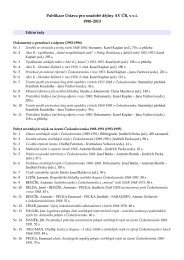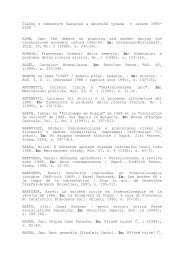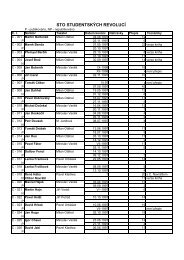SOU OBà ÄJINY - Ãstav pro soudobé dÄjiny AV - Akademie vÄd ÄR
SOU OBà ÄJINY - Ãstav pro soudobé dÄjiny AV - Akademie vÄd ÄR
SOU OBà ÄJINY - Ãstav pro soudobé dÄjiny AV - Akademie vÄd ÄR
You also want an ePaper? Increase the reach of your titles
YUMPU automatically turns print PDFs into web optimized ePapers that Google loves.
522 Soudobé dějiny XVI / 2–3<br />
the weighing of guilt, the <strong>pro</strong>blematization of the categories of culprit and victim,<br />
or reflections on one’s own responsibility.<br />
The Pasts That Divide: The Czechoslovak<br />
Social Democratic Party, 1989–92<br />
Tomáš Zahradníček<br />
In the mid-1990s the Czechoslovak Social Democratic Party (Československá strana<br />
sociálnědemokratická), next to the Civic Democratic Party, became the strongest<br />
political force in the country. This article is concerned with the question of why it was<br />
unable after the Changes of November and December 1989 to influence the Czech<br />
public and become involved in the political debates about the Communist past. The<br />
author considers who actually were the first actors in Social Democratic politics, and<br />
stresses the role played by the most important initial differences between them in<br />
their attitudes towards tradition and certain personal lives before November 1989.<br />
According to these differences, the author divides the Social Democrats into three<br />
main groups: the ‘restitution group’, the ‘continuity group’, and the ‘new group’.<br />
The numerically largest group, the ‘restitution group’ (led by Slavomír Klaban,<br />
born in 1922), attempted to restore the Social Democratic Party after the fortyyear<br />
break in its activity. In doing so, this group based itself on the bitter memory<br />
of the <strong>pro</strong>-Communist faction’s having taken control of the party in 1948, and on<br />
the repressive measures that followed. The ‘continuity group’, comprising exile<br />
Social Democrats (led by Karel Hrubý, born 1923, and Jiří Loewy, 1930–2004) and<br />
‘independent Socialists’ who had signed Charter 77 (led by Rudolf Battěk, born<br />
1924, and Jaroslav Mezník, 1928–2008) had the experience of many years of active<br />
resistance to the Communist régime. Apart from them, new activists, who previously<br />
had practically nothing in common with the party, joined the Social Democrats after<br />
the fall of the ‘ancien régime’. Amongst them were former Communists, some of<br />
whom were active in the Obroda reform club. These fundamental starting points<br />
ran up against the actual position of the Social Democrats after the Changes of late<br />
1989. This position was determined by several external factors: the Civic Forum did<br />
not wish to see political parties develop, the public quickly and for the long-term<br />
abandoned the slogans of Socialism (even if reformed), and the Communist Party<br />
was able to survive in the new circumstances and sought to represent not just its<br />
traditional members, but all left-wing voters. This situation required political action<br />
from the Social Democrats in the space between the Civic Forum and the Communist<br />
Party of Bohemia and Moravia, for which the nascent party was ill prepared. The first<br />
elected leadership under the former exile Social Democrat functionary Jiří Horák<br />
(1924–2003) had a weak position and many other figures of authority, from diverse<br />
political milieux, struggled for preeminence, seeking to use the Social Democratic<br />
name to assert their own views. But in fact any topic that was related to the past<br />
divided them. That changed after the election of Miloš Zeman (born 1944) as head of


